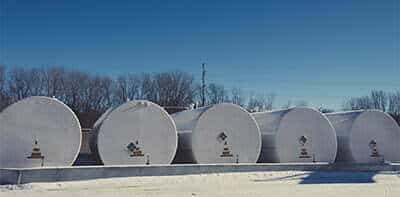 Magnetostrictive Float Level Probes are built to provide highly accurate, continuous measurements in the toughest environments. The electro-magnetic measurement technology is extremely precise, and when protected by an appropriate stem material, it is unaffected by almost all potential environmental interferences. While other sensor technologies might handle one or two of these challenging situations, magnetostrictive probes can work through all of them.
Magnetostrictive Float Level Probes are built to provide highly accurate, continuous measurements in the toughest environments. The electro-magnetic measurement technology is extremely precise, and when protected by an appropriate stem material, it is unaffected by almost all potential environmental interferences. While other sensor technologies might handle one or two of these challenging situations, magnetostrictive probes can work through all of them.
Alcohols of all varieties like to give off vapors, making them hard for ultrasonic sensors to measure accurately. Magnetostrictive probes are not distracted by such vapors. The floats are substantial enough that they won't be buffeted by any vapors, sitting instead at the surface of the liquid. So whether you use ethanol (or methanol, or any other alcohol) as a food-grade processing component or as an ingredient, or you just need to measure stored stock, a magnetostrictive probe is going to do the job right.
 Petroleum-based fuel products, especially diesel fuel, also produce a lot of vapors. Many engines run on diesel fuel, from large, mobile equipment to stationary, backup electric generators, and running out of fuel is not an acceptable option. Whether you are storing diesel for use and distribution during everyday operations, or for emergency use only, you need to know how much diesel you have. And fumes aren't the only measurement issue for diesel: its high flammability means a sensor needs high-end hazardous location ratings. Here, again, magnetostrictive technology makes accurate diesel fuel level measurement easy. And, when combined with a remote level monitoring system interface, magnetostrictive probes provide not only continuous level measurement, they make those measurements accessible from anywhere.
Petroleum-based fuel products, especially diesel fuel, also produce a lot of vapors. Many engines run on diesel fuel, from large, mobile equipment to stationary, backup electric generators, and running out of fuel is not an acceptable option. Whether you are storing diesel for use and distribution during everyday operations, or for emergency use only, you need to know how much diesel you have. And fumes aren't the only measurement issue for diesel: its high flammability means a sensor needs high-end hazardous location ratings. Here, again, magnetostrictive technology makes accurate diesel fuel level measurement easy. And, when combined with a remote level monitoring system interface, magnetostrictive probes provide not only continuous level measurement, they make those measurements accessible from anywhere.
A third industrial use of magnetostrictive probes is found in industrial waste management: CO2 recapture. Often, recaptured waste CO2 is compressed and cooled until it condenses to a liquid. The combined pressure and temperature requirement for liquid CO2 make it difficult to measure for several level measurement technologies. But magnetostrictive probes can handle both the low temperature and the increased pressure (at least 5.1 atms, roughly 75 psi) without sacrificing measurement accuracy. They are simply unfazed by the tough environment. As long as there is liquid CO2 to move the float, the probe will provide the right reading.
Fumes, vapors, explosive environments, and extreme pressures and temperatures, taken individually, are threats to accurate level measurement. But added together, as they often are in common industrial situations, they can make it nearly impossible. Unless you have magnetostrictive probes. Magnetostrictive continuous float level sensors can't be bullied by any of these environmental interferences. They work right through the challenges that distract or disqualify other level sensing technologies to deliver continuous, accurate readings.
Curious about how a magnetostrictive probes can manage your industrial liquid measurements? Give our Measurement Experts a call, or drop them an email today. They would love to help you get the best level and pressure measurement technology to your needs.
top photo credit: Tony Webster via flickr.com Creative Commons 2.0 cropped